The turquoise pools of Havasu Falls look unreal in photos, but getting there takes planning and permission. You’ll need a permit from HavasupaiReservations.com, decide whether to hike 11 miles or fly in, and choose between camping or the small lodge. I’ll walk you through booking windows, trail logistics, essential gear, water tips, and what to expect in Supai so you can plan a safe, responsible trip — and avoid the common pitfalls that spoil visits.
But First, the Basics
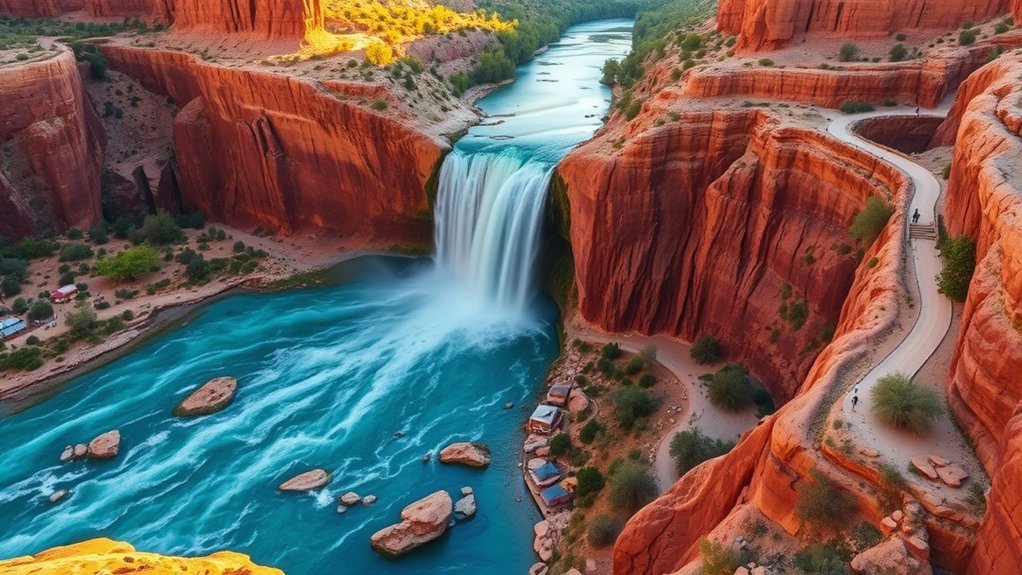
Before you go, know that Havasu Falls sits on the Havasupai Indian Reservation and you’ll need a permit reserved online when bookings open February 1 — the official season runs February through November, with March–May and September–November offering the best weather. You’ll plan reservations early: campground reservation requires a minimum three-night stay and the lodge has similar rules. Expect an 8-mile hike to Supai Village plus about 2 miles to the campground — round trip is at least 20 miles — so gear up. Bring sturdy hiking shoes, a gallon of water per person, sunscreen and food; there’s no reliable drinking water on the trail and limited village amenities. Treat the journey as wilderness camping, not a day trip.
Permit Timeline, Costs, and How to Book
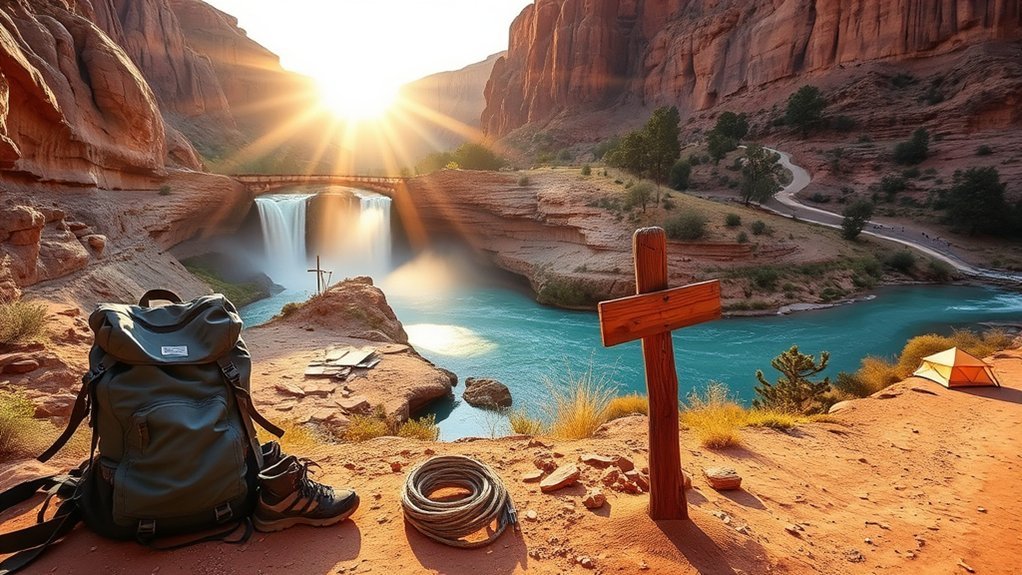
Now that you know the basics of hiking and camping at Havasu Falls, you’ll want to lock in permits the moment they’re released: reservations open each year on February 1 at 8 a.m. You’ll use HavasupaiReservations.com; spots sell out fast. Know the permit timeline: cancellations post daily at 8 a.m., so check for last-minute openings. Costs run roughly $455 per person for a four-day, three-night camping permit or about $2,277 per room for a lodge stay (up to four guests). Reservations require a minimum stay of three nights, allow up to 12 people (max four permits per account), and payment is non-refundable. Make one designated booker for group reservations to streamline payment and avoid mistakes.
| Item | Price | Notes |
|---|---|---|
| Camping | $455/person | 4 days, 3 nights |
| Lodge | $2,277/room | Up to 4 guests |
| Policy | — | Minimum stay, non-refundable |
Getting There: Trailhead, Transportation, and Helicopter Options
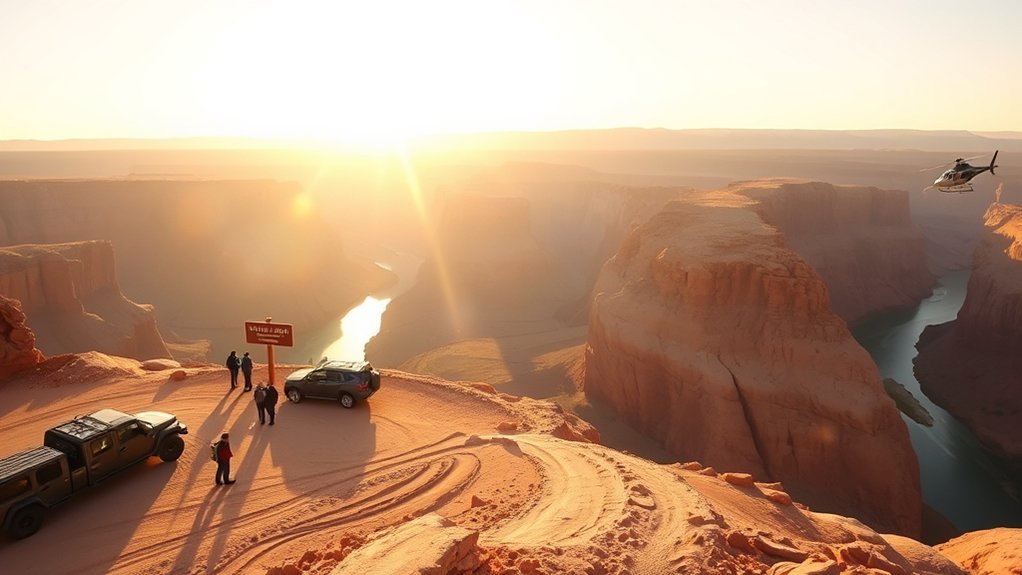
You start at the Hualapai Hilltop trailhead for an 8-mile hike to Supai Village and another 2 miles to the campground and falls, so plan for a strenuous 20-mile round-trip. You can hire pack mules to carry gear but should carry your own essentials—sturdy shoes and at least one gallon of water per person are nonnegotiable, especially in triple-digit heat. If you want to skip the trail, Airwest Helicopter offers $100 per person one-way flights (kids under 2 fly free) on a first-come, first-served basis.
Hualapai Hilltop Trailhead
One clear marker of your trip to Havasu Falls is the Hualapai Hilltop Trailhead, the lone access point to Supai Village—about 8 miles down the trail and another 2 miles to the campground and falls—so plan accordingly for a roughly 10-mile round trip if you’re hiking. From the Hualapai Hilltop parking area you’ll start the hike to Havasu; arrive early to secure a spot, especially in peak months. You can hike to Havasu carrying your pack or use pack mules for gear, but personal items suit an immersive trek. If you’d rather skip the slog, Airwest Helicopters flies first-come, first-served for $100 each way with no advance reservations. Plan logistics around this single access point.
Hike vs. Pack Mule
Although the 8-mile descent from Hualapai Hilltop to Supai Village (and the extra 2 miles to the campground and falls) can be done by mule, most visitors choose to carry their own pack for a more immersive experience; either way you’ll face a minimum 20-mile round trip and must plan water, timing, and logistics accordingly. You’ll decide between a steady hike and hiring pack mules to haul personal gear. If you hike, start before sunrise to beat summer heat that can exceed 115°F, carry at least a gallon of water per person, and pace yourself for the hike to Havasupai. Pack mules ease weight but limit what you control and expect cargo rules. At camp, you’ll appreciate having essentials on your back and hands-free for Havasupai Falls explorations.
Airwest Helicopter Service
If hauling your own pack or hiring mules doesn’t appeal, Airwest Helicopters offers a fast, scenic alternative that skips the 8-mile trail from Hualapai Hilltop to Supai Village. You’ll pay $100 per person each way (children under 2 fly free) and board first-come, first-served—no reservations—so arrive early. The short flight covers a scenic distance that gives unique aerial perspectives of the canyon and Havasu Falls, dramatically reducing travel time versus hiking. Note flights are weather-dependent; check conditions before you go and have a backup plan. You can still hire pack mules for gear, but hikers usually carry essentials. Use the helicopter when time, mobility, or photography priorities outweigh the traditional trail experience.
Where to Stay: Campground vs. Havasupai Lodge
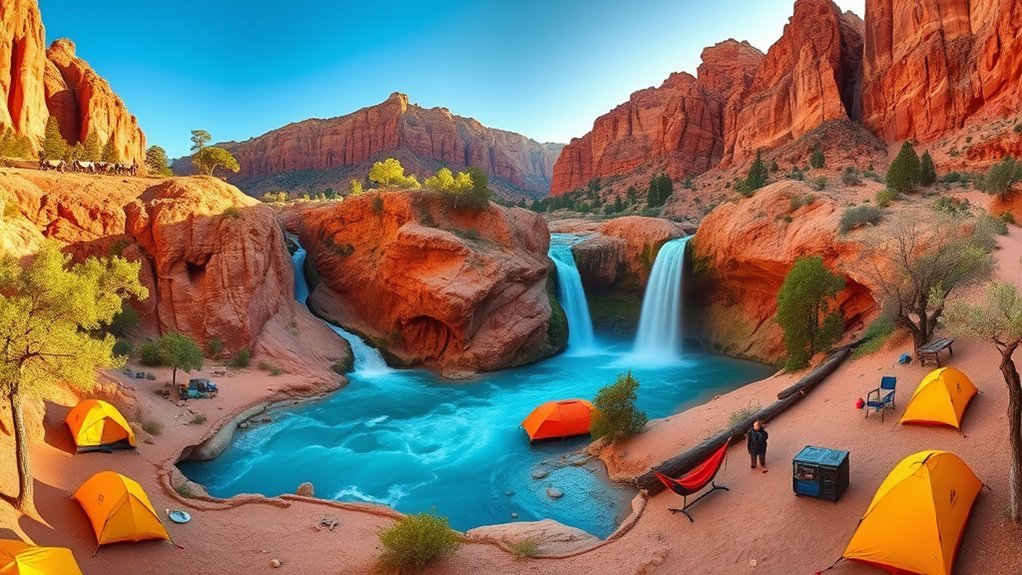
You’ll choose between rustic riverside camping on the mile-long Havasupai Campground or a basic room at Havasupai Lodge in Supai Village. The campground means bringing your own tent, food, and gear and following pack-in/pack-out rules, while the lodge offers a room with a three-night minimum and fewer camping logistics. Both require advance reservations and planning for water and supplies, so pick the option that fits your comfort and gear readiness.
Campground: Rustic, Riverside Camping
When you choose the Havasupai Campground, you’re signing up for rustic, riverside camping where the creek’s thunder and the falls’ mist become your closest neighbors; there are no assigned sites, roughly 300 people share the primitive, pack-in/pack-out space, and you’ll need to bring your own tent, sleeping bag, and all food because supplies in Supai Village are limited and costly. You’ll make campground camping reservations online at HavasupaiReservations.com (book before February 1); the Havasupai Tribe requires a three-night minimum. The experience is immersive and raw — no-frills, close to waterfalls, and governed by a strict pack-in, pack-out policy. Pack lightweight, plan meals, respect shared space, and prepare for changing canyon weather.
| What to bring | Why it matters |
|---|---|
| Tent, sleeping bag | Shelter, warmth |
| Food, water | Limited, expensive supplies |
Havasupai Lodge: Basic Room Option
For visitors who prefer a bed and running water after a day on the trail, the Havasupai Lodge in Supai Village offers a basic room option about 2 miles from Havasu Falls. You’ll get simple comforts—air conditioning and showers—instead of riverside camping, and the lodge’s basic accommodations feel like a welcome respite after the hike. Reservations open June 1 by phone and require a minimum three-night stay; expect to pay roughly $2,277 per room for up to four guests. Supplies are limited in Supai Village, so plan to bring your own food. Demand is high, so secure your stay early and act quickly. Choosing the lodge trades rustic immersion for practical convenience and easier access to the falls.
The 11-Mile Hike: Route, Mile Markers, and Trail Challenges
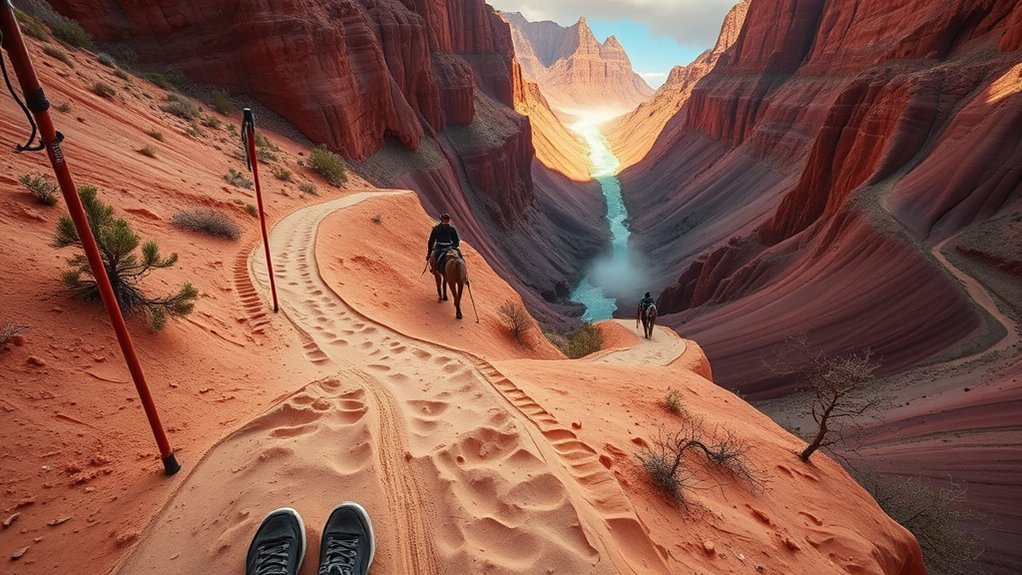
Although the trail starts gently, the 11-mile trek from Hualapai Hilltop to Havasu Falls quickly shifts into steep switchbacks and exposed desert, so plan for strong legs and early starts. You’ll cover about 7 miles to Supai Village, then 2 more to the campground and Falls; the round trip is at least 20 miles. Temperatures can surpass 100°F, so start before heat peaks. No drinking water exists on the trail, so you must carry a gallon per person. Flash floods during monsoon season (July–September) can wash out sections; check forecasts and your reservation before leaving. Expect uneven footing, loose rock, and long exposed stretches that test pace and endurance.
| Mile Marker | Terrain | Hazard |
|---|---|---|
| 0–7 | Desert/switchbacks | Heat |
| 7–9 | Village/trail | Crowds |
| 9–11 | Canyon/camp | Flash floods |
What to Bring: Packing List and Water Plans
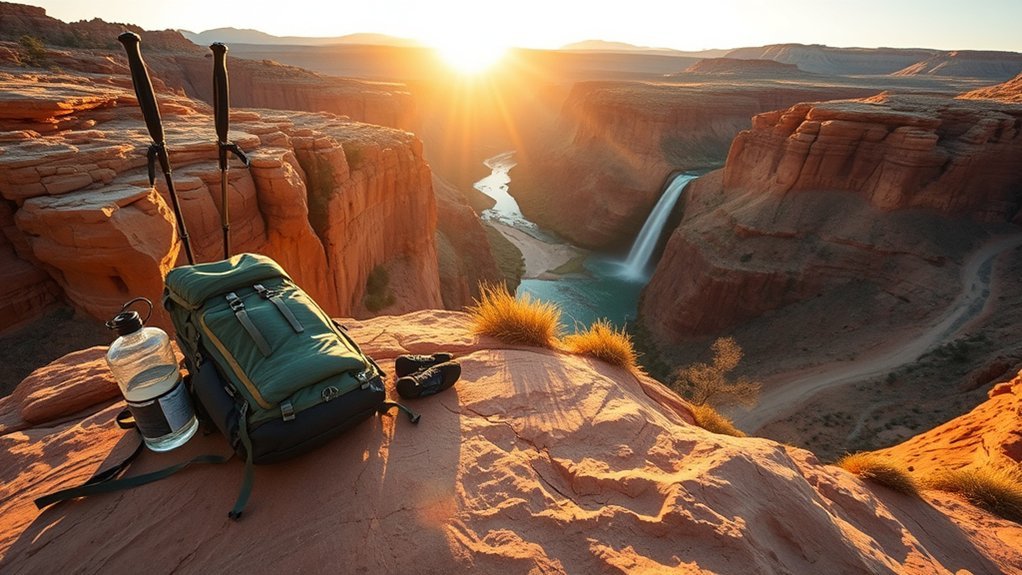
Because you’ll be carrying everything you need for an 11-mile descent and at least a 20-mile round trip, pack deliberately: bring a minimum of one gallon of water per person, sun protection (sunscreen, wide-brim hat), sturdy hiking shoes plus water shoes for pools, and a basic first-aid kit with any personal meds. Don’t expect water available on the trail—filtering devices won’t help where there’s no source. Essential packing items also include snacks, extra toilet paper, a bathing suit, towel, tent, sleeping bag, pad, inflatable pillow, and a portable stove and fuel for Havasupai camping since no meals are provided. Bring hiking poles for steep switchbacks and monitor weather conditions; high heat demands shade, electrolytes, and pacing to stay safe.
What to Expect When You Arrive in Supai Village
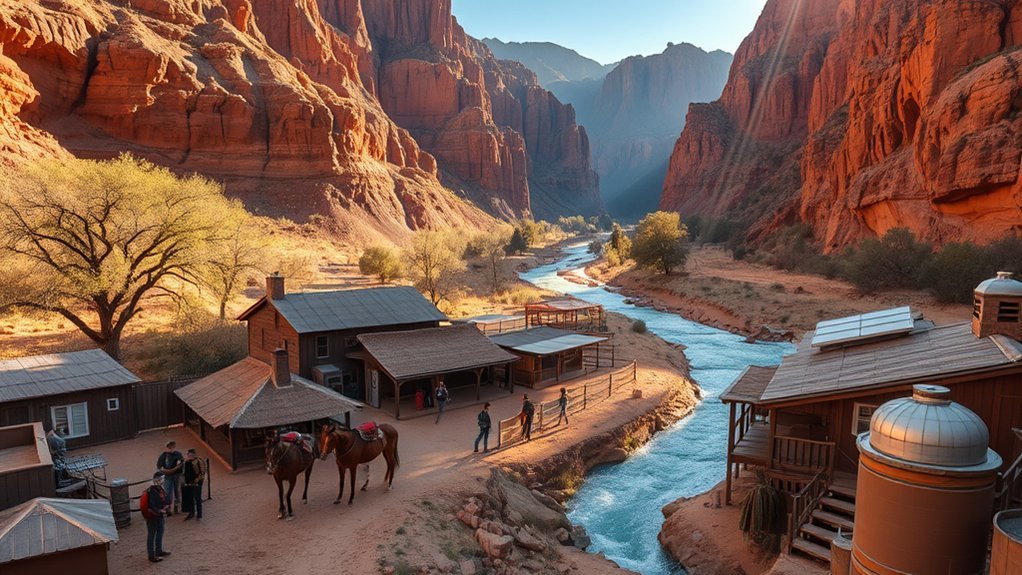
When you reach Supai Village after the long descent, check in immediately at the Tourist Check-In Office— the reservation holder will need a photo ID and the printed confirmation—then pause to adjust: this small community is the gateway to Havasu Falls but also a living village with its own rhythms and rules. You’ll hand over your Havasupai Reservation details, get briefed, and be reminded that photography in the village is restricted to respect residents. Expect quiet streets, friendly residents, and simple services. Plan for no cell service or Wi‑Fi; navigation and communication must be sorted beforehand. Helpful sights and realities you’ll notice:
- A modest market with snacks, water, and basic supplies
- A café with irregular hours
- Mules and pack riders coming through
- Simple accommodations and communal spaces
Safety, Regulations, and Leave No Trace Practices
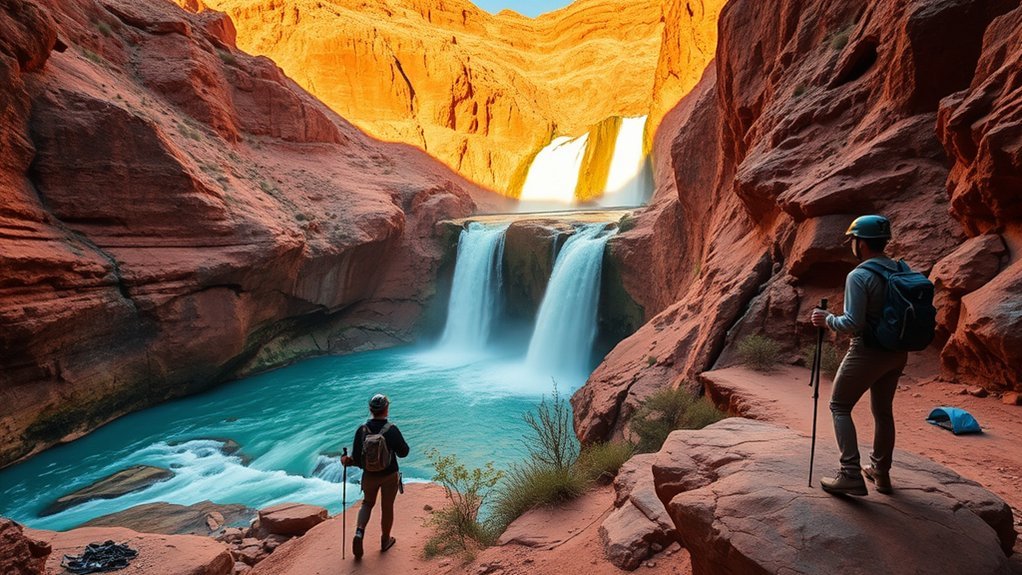
After you check in and settle into Supai Village, you should quickly orient yourself to the rules and practices that keep Havasu Falls beautiful and safe for everyone. Follow regulations: no alcohol, drugs, or drones, and respect quiet hours. Practice Leave No Trace—pack out trash, avoid campfires, and leave wildlife undisturbed—to preserve the canyon’s colors and pools. Be weather-aware: flash flood risk rises during storms, so monitor conditions and avoid exposed areas. Wear appropriate footwear—rocks are slippery and injuries happen fast—move slowly around falls and trails. Use campground composting toilets responsibly and bring extra toilet paper. These simple, practical steps protect you, the village, and this fragile landscape so future visitors can enjoy it too.
Best Time to Visit and Seasonal Weather Considerations
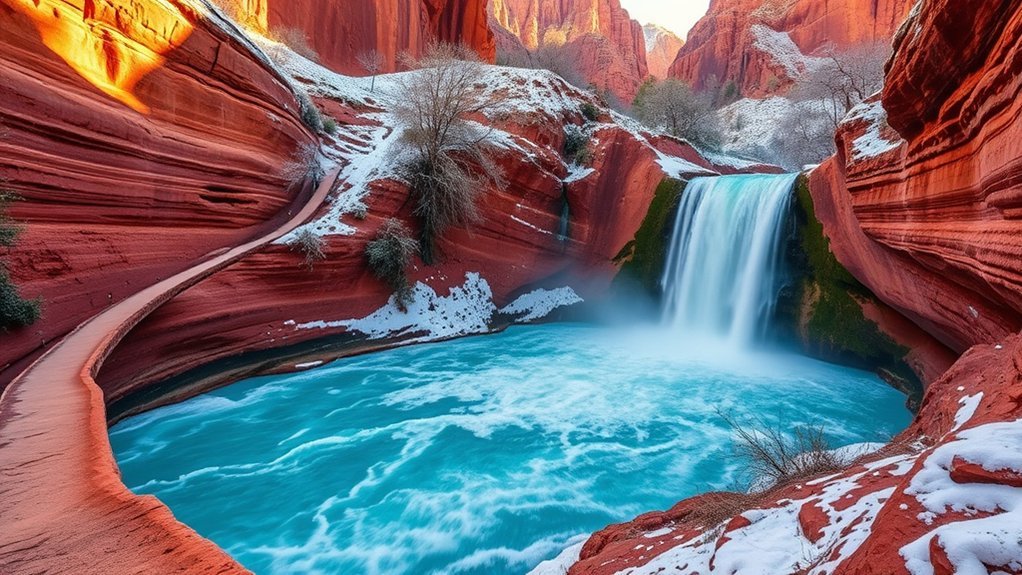
If you want the most comfortable hike and swim, plan your trip for spring (March–May) or fall (September–November), when temperatures are moderate, water’s inviting, and crowds are thinner than summer—April brings pleasant days and chilly nights ideal for camping, while October is generally mild but can feel a bit warmer. You’ll experience the best time to visit Havasu Falls by avoiding summer heat and monsoon flash floods. Seasonal weather affects trail safety, swimming, and camping comfort, so early planning matters.
- Early spring offers cooler temps, turquoise pools, and fewer crowds.
- April nights can be cold; bring warm layers for camp.
- Summer often exceeds 100°F and risks trail closures.
- Monsoon season (July–September) can trigger flash floods; avoid hiking then.
Frequently Asked Questions
What Is the Best Time of Year to Go to Havasuupai Falls?
The best time is spring (March–May) and fall (September–November). You’ll enjoy mild weather conditions, lower crowd levels, seasonal activities, better trail conditions, ideal photography tips opportunities, and comfortable camping and swimming.
How Fast Do Havasupai Permits Sell Out?
They often sell out within minutes to hours; you’ll face extreme havasu permits demand during peak booking times. Use permit availability tips, prioritize securing reservations early, monitor cancellation policy insights, and read visitor experience reviews.
Can You Visit Havasu Falls for a Day?
Only 1% manage a same‑day visit; you can’t—day trip’s not allowed. You’ll plan multi‑day hiking options, follow photography tips, heed swimming safety, watch local wildlife, and account for weather considerations to enjoy it responsibly.
Where Do You Pick up the Permit at Havasupai?
You pick up the permit at the Tourist Check-In Office in Supai Village; you’ll present required identification, printed reservation, learn permit fees details, hiking permit regulations, permit reservation process steps, and the permit cancellation policy.
Conclusion
You’ll feel the canyon open as you crest Hualapai Hilltop—turquoise pools below, cottonwood shade along the creek—so move deliberately: secure your permit Feb 1, pack sturdy boots, lots of water, and a headlamp, and set expectations for an 11‑mile hike plus village stroll. Camp under stars or stay in Supai, follow regs, and tread lightly; the falls reward patience, preparation, and respect with a wild, glittering hush you’ll remember.

